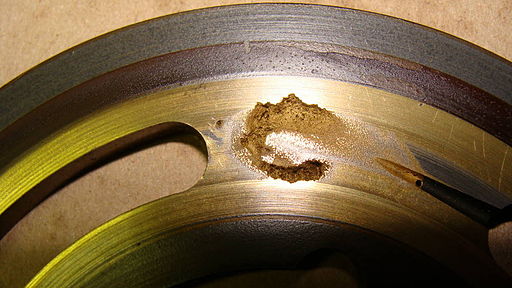The most problematic form of hydraulic air contamination is entrained air. In this post, we talk about why it's a problem, what causes it, and how you can prevent it.

This is a continuation of a multi-part series on air contamination. Here are the first two posts:
Types of Air Contamination in Hydraulics &
Foaming Hydraulic Fluid: What You Need to Know
Entrained Air
Entrained air is best described as bubbles less than 1 mm in diameter (about the thickness of your ID card or credit card) that are suspended below the surface of your hydraulic fluid. Unlike foam, entrained air doesn’t just cluster on the surface of hydraulic fluid, which is why it is so problematic.
Why Entrained Air is a Problem
Let’s talk about what entrained air can lead to:
- Poor response from the control system
- Spongy operation
- Less efficiency
- Deterioration of the hydraulic fluid
- Thinning of the hydraulic fluid
- Accelerated wear of critical surfaces
- Cavitation erosion
- Increased noise
All of these symptoms can impact the efficiency, performance, and life of your final drive motors.
Entrained Air and Final Drive Motors
When entrained air is trapped in your hydraulic fluid, it will lead to a reduction in both performance and efficiency. But one of the most problematic issues for final drives is the accelerated wear of critical surfaces which is caused by the hydraulic fluid losing viscosity because of the presence of air. As the hydraulic fluid thins out, it won't be able to provide the necessary protection and lubrication for surfaces within your final drive motor. Over time, this leads to issues with performance and efficiency and will cause a final drive to fail prematurely.

Here we see cavitation damage in the form of serious pitting.
The other major problem caused by entrained air in the hydraulic fluid is cavitation. When a bubble of entrained air collapses, a high-speed shockwave is released due to the walls of the bubble colliding with each other. Any solid surfaces nearby (including valve plates in a final drive motor) get hit with pulse loads resulting from the shockwaves as the bubble collapse. Over time, the repeated stress of these shockwaves begin to damage the nearby surfaces. The surface damage takes the form of pits or craters and will eventually cause failure.
Entrained air can affect other parts of your hydraulic system, including the pump. In this article from Pumps and Systems, the author talks about problems with dry running (and accelerated wear of) seals in your pumps when the entrained air prevents lubrication from reaching them and vibration as the load on the impellers becomes unbalanced.
How Does Entrained Air Form
We've previously talked about how hydraulic fluid can still function extremely well with up to 12% dissolved air by volume. This dissolved air, however, can turn into entrained air under certain circumstances that depend on an increase in the temperature of the hydraulic fluid or a decrease in static pressure.
This release of dissolved air most often occurs at the pump inlet as a result of ...
- Inlet filters or suction strainers that have become clogged
- A reservoir breather that is either undersized or has become clogged
- An inlet with multiple bends, too small a diameter, or excessive length
- Issues with the pump shaft seal
- Collapsed, leaking, or porous intake line
- Loose fittings or clamps on the intake line
- Turbulence caused by intake-line isolation valves
- Too much vertical distance between the pump intake and the minimum fluid level in the reservoir
- Low fluid levels in the reservoir
- Improper bleeding
- Splashing or agitation in the reservoir when fluid is added
You'll notice that none of these are directly related to your final drive motor, even though your drive motor may suffer from the effects of cavitation. This means you need to track down what's causing the entrained air if you've had a final drive with cavitation issues. And it also means that other components within your system may be suffering damage from cavitation.
Dealing with Air Entrapment
Good maintenance is the key to preventing air entrapment. Check for the problems that are tied to the release of dissolved air that we just discussed in the previous section. This includes clogged inlet filters, issues with inlet lines, clogged reservoir breathers, and low fluid levels. Avoid splashing when adding hydraulic fluid, prefill components, and bleed the system correctly.
There are also air extractors and air bubble removers that can do a good job of removing entrained air. In addition, there are hydraulic oil conditioning systems. In addition, there are additives for hydraulic oil that help with controlling the amount of air in the fluid as well as hydraulic fluids with good air release properties.
Conclusion
Entrapped air can adversely affect various components in your hydraulic system. The best approach to preventing damage from air entrapment lies in preventing it, but if it's already a problem then we suggest contacting the manufacturer to find out what type of air extractors or hydraulic fluid additives can minimize its effects.


